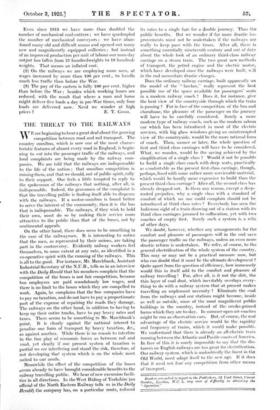COAL WAGES AND PRICES
THE difference between the miner's wage per ton and the retail price paid by the domestic coal consumer still seems to be a great puzzle to many people, notwith- standing the official figures and reports issued from time to time. It is suggested that the new Royal Commission ought to spend much of its time inquiring into the dis- tributive side of the business, notwithstanding the fact that only three years ago a special committee went into the details, since when there have been no material changes in the trade. Profound misconception exists in the public mind. Perhaps this is excusable when a noted miners' leader declares that "coal for which consumers pay half a crown per hundredweight is produced by the miner—brought to the pit-top--for half a crown per ton," What are the facts ?
First, no miner produces coal, or brings it to the pit- top, by his own unaided labour. It takes many men to get the coal from the seam to the truck. The actual hewer may work for 2s. 6d. per ton, plus percentages and allowances ; but many other men have to be employed and paid—engineers, hauliers, trammers, screeners, and others. In round figures, our recent costs have been 13s. 6d. for labour ; 4s. 6d. for other costs, including horses, timber, &e., which, in turn, mostly goes for wages indirectly ; and about is. per ton for dividends and royalties, the former being small returns on capital invest- ments and the latter meagre compensations for the ground occupied and damaged by the mining operations.
Taking next the 19s. or thereabouts which is the pit- head price, what do we find.? It is an average price. It is not the price of house coal. Only a relatively small percentage of the output is fit for the domestic grate. Much of the small and inferior industrial coal is sold for as little as 7s. a ton. The best house coal may fetch 25s. or 30s. at the pithead. It is wrong, therefore, to contrast the price of house coal with the average pithead price, or cost, just as it is wrong to contrast the pay of the hewer with the price of the coal delivered in, say, London.
On top of the pit price we have the following charges per ton, in case of a typical grade for domestic use in London :--
s. d.
Rail Rates (mostly wages) .. 8 9 per ton.
Wagon hire (largely wages) .. 2 0 „ Cartage, horses, Sce. (mostly wages) .. 2 10 „ &wits (mostly wages for making and mending)
4
Pf
Loss on smalls, deficiencies, &e.
9
If
Siding rent, wharf, weigh, Ste.
4
Clerical and managers' salaries, &e. .. 2 2
PI
Establishment charges, rents, rates, postage, stationery, bad debts, Sze. .. 1 11 „
Thus it will be noted that very nearly the whole of the cost, from the coal seam to coal cellar, goes for labour, from making the pick to growing the horse food. If we desire to know why the final retail price is high we have to consider the following points : (1) Our coal output per unit of labour is very lo. Forty years ago we had 25 hundredweights of coal per mine workel: per working shift. The direct wage cost was barely 5s. per ton. Now, with vastly improved appliances, _ ventilation, &c., we get barely 18 hundredweights per man-shift, and the direct wage cost is about 18s. 6d. Our current low output per man cannot possibly yield good wages and cheap coal at the same time. In some countries they get high wages and cheap coal by the process of a huge production per man. In other countries they obtain cheap coal by means of low wages. We cannot have it both ways. If we have good wages on a small output, then our coal must be costly. If we force cheap coal, concurrently with a low output, then we must " sweat " the miners. Even since 1913 we . have more than doubled the number of mechanical coal-cutters ; we have quadrupled the number of mechanical conveyors ; we have aban- doned many old and difficult seams and opened out many new and magnificently equipped collieries ; but instead of an improved production per unit of labour our man-day output has fallen from 21- hundredweights to 18 hundred- weights. That means an inflated cost.
(2) On, the railways we are employing more men, at wages increased by more than 100 per cent., to handle much less traffic than before the War.
' (3) The pay of the carters is fully 100 per cent, higher than before the War ; besides which working hours are reduced, with the ' result that where a man and horse might deliver five loads a day in pre-War times, only four loads are delivered now. Need we wonder at high



























































 Previous page
Previous page